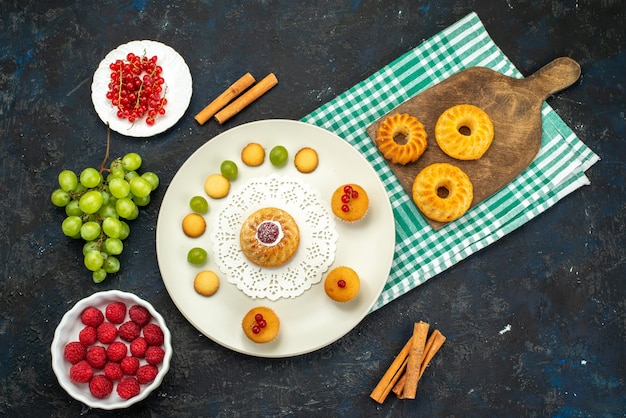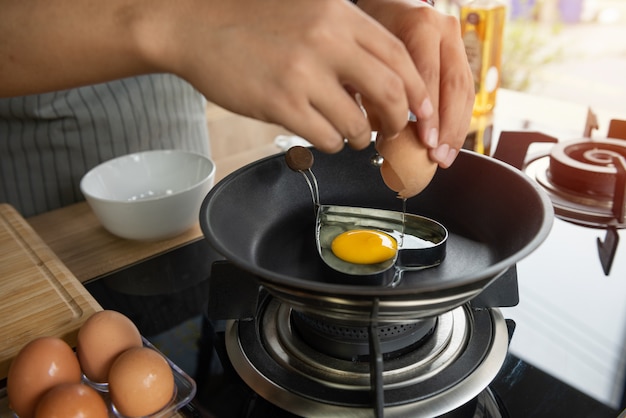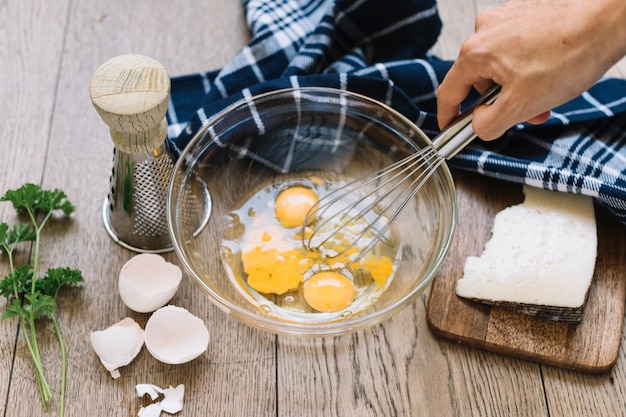(Part 1) The Egg's Journey – From Shell to Plate

Eggs 101: A Peek Inside
Before we delve into the world of temperature, let's talk about the eggs themselves. Those oval-shaped wonders are actually living cells, packed with nutrients, proteins, and vitamins. But today, we're focusing on the two key players: the albumen (the white) and the yolk.The albumen, that clear, slightly viscous liquid, is mostly water and protein. When heated, these proteins unwind and bind together, creating the firm, white texture we know and love. The yolk, on the other hand, is a rich, golden sphere containing fat, protein, and water, and it's packed with vitamins and minerals. Its higher fat content is what gives it its characteristic creamy texture and makes it hold onto its liquid form for longer during cooking.The Science of Egg Transformation: From Liquid to Solid
Think of the cooking process as a molecular transformation. When you apply heat to an egg, the proteins in both the albumen and yolk start to unravel, like a long strand of yarn being untied. As they unwind, they bump into each other and begin to bond together, forming a solid structure. The higher the temperature, the faster this unraveling and bonding process happens. This is why a high temperature leads to a firm, hard-boiled egg, while a gentle heat allows for a softer, more delicate texture.(Part 2) The Temperature Game: Finding the Sweet Spot

Understanding the Temperature Zones: A Guide for Egg Whispering
Now, let's talk about the heart of the matter – the temperatures that govern the transformation of your humble egg. There are three main temperature zones to keep in mind, each with its own set of magic:- The Low Zone (150°F - 185°F): This is the realm of gentle cooking. Think poaching, simmering, and baking. In this zone, the heat is just enough to coax the proteins into a delicate, tender structure, resulting in a soft, moist egg.
- The Medium Zone (185°F - 200°F): This is where things get exciting. This is the zone for sunny-side-up and over-easy eggs, where we want a firm white and a runny yolk. The heat here is a little more assertive, setting the white quickly while leaving the yolk luxuriously runny.
- The High Zone (Above 200°F): This is the domain of hard-boiled and scrambled eggs. Here, the heat is intense, rapidly setting both the white and the yolk, leading to a firm, opaque structure.
Temperature: The Sculptor of egg textures
It's not just about the temperature itself; it's also about how long we let the egg sit in that temperature zone. The longer the cooking time, the more time the proteins have to unravel and bond, leading to a firmer, more cooked texture.Imagine a poached egg, cooked in a simmering water bath at a gentle 165°F to 175°F. The low temperature and slow cooking time create a delicate, almost jelly-like consistency. The whites are tender and translucent, while the yolk remains perfectly runny.Now, picture a hard-boiled egg, cooked at a vigorous 212°F. The intense heat and longer cooking time result in a firm, opaque yolk and a rubbery white.(Part 3) Cracking the Code for Different Cooking Methods

1. poached eggs: A Gentle Dance in Simmering Water
Poached eggs – the epitome of elegance and sophistication. To get them right, you need a gentle heat, around 165°F to 175°F. Think of it as a gentle dance in a simmering water bath. My secret weapon for poaching? A large pot filled with about an inch of water, gently simmering. The key here is to create a gentle whirlpool, swirling the egg whites around as they cook to form a beautifully uniform shape.2. Simmered Eggs: The Gentle Route to perfect eggs benedict
Simmering eggs is a bit like a gentler version of poaching. It's perfect for dishes like Eggs Benedict, where you want a soft, tender egg with a runny yolk. The ideal temperature for simmering? Around 175°F to 185°F. The slow, gentle heat allows the eggs to cook evenly and retain their moisture. It's a method that yields a luxuriously creamy yolk and a tender, almost melting white.3. Sunny-Side-Up and Over-Easy: A Quick Kiss of Heat
For these iconic breakfast dishes, you want a skillet or pan that heats up evenly and consistently. Aim for a medium temperature, around 190°F to 200°F. The goal here is to cook the whites quickly while keeping the yolk runny. My trick? A quick cover of the pan for a few minutes to help the whites set even faster. The result? A perfectly firm white surrounding a luscious, runny yolk.4. Over-Medium and Over-Hard: A Journey to Firmness
Over-medium and over-hard eggs require a little more cooking time and a slightly higher temperature, around 200°F to 210°F. Here, the goal is to firm up the yolk while maintaining a delicate texture. Keep the heat medium-high, allowing the yolk to cook without drying out. The result? A firm, slightly runny yolk for over-medium and a completely firm yolk for over-hard.5. Scrambled Eggs: A Symphony of Flavor and Texture
Scrambled eggs, the ultimate comfort food, offer a canvas for experimentation. The best temperature for scrambling is around 200°F to 210°F, a temperature that allows the eggs to cook quickly but not burn. You can achieve this in a pan or even use a microwave. Just be sure to stir constantly, ensuring even cooking and a silky smooth texture.(Part 4) Perfecting the Hard-Boiled Egg: The Art of the Firm Yolk
The hard-boiled egg – a classic for a reason. But getting it right can be a bit tricky, which is why temperature is key. For a perfectly hard-boiled egg, the ideal temperature is 212°F – that's boiling point.The Time Factor: A Dance of Textures
The time you boil the egg will determine the texture of the yolk. For a soft yolk, you'll need around 6 to 7 minutes. For a hard yolk, aim for 10 to 12 minutes. Remember, the longer the cooking time, the firmer the yolk will become.(Part 5) The Egg-cellent Tools: Your Culinary Allies
Thermometers: Your New Best Friends in the Kitchen
I can't stress this enough: a thermometer is your best friend when cooking eggs. It gives you an accurate reading of the temperature, ensuring your eggs cook to perfection every time. I use both a digital thermometer and a candy thermometer, depending on the cooking method. The digital thermometer is great for precise temperature readings in a water bath, while the candy thermometer is ideal for monitoring the temperature of a skillet or pan.The Right Cookware: The Foundation for Success
While it's not all about the cookware, the right pan can certainly make a difference. For frying, I prefer a cast iron skillet. It heats up evenly and holds the heat well, resulting in consistently cooked eggs.For poaching, a wide, shallow saucepan is ideal for creating a gentle whirlpool and ensuring even cooking.(Part 6) The Art of the Egg: Beyond the Basics
Beyond the Basics: A World of Egg-sploration
Okay, so we've covered the basics, but there's more to eggs than just cooking them. You can use them in baking, creating airy and light cakes and pastries. You can create amazing omelets and frittatas, filled with vibrant vegetables and savory cheeses. You can even add them to smoothies for a protein boost!Experimenting with Flavors: A Culinary Playground
Don't be afraid to experiment with different flavors and ingredients. You can add fresh herbs like chives, parsley, and dill to your scrambled eggs. You can fold in crumbled bacon or sausage for a hearty breakfast. You can even add a touch of spice with chili flakes or paprika. The possibilities are endless.(Part 7) Egg-cellent FAQs: Your Egg-speriences Answered
1. What Temperature Should I Store Eggs in?
Eggs should be stored in the refrigerator at a temperature between 35°F and 40°F. This ensures that they stay fresh and safe to eat.
2. Can I Freeze Eggs?
You can freeze eggs, but they should be beaten first. This prevents them from separating and becoming watery when thawed. You can freeze them in a container, ice cube trays, or even in their shells.
3. How Do I Tell if an Egg is Fresh?
To check for freshness, put the egg in a bowl of cold water. If it sinks to the bottom and lies flat, it's fresh. If it rises to the surface, it's older. The older the egg, the more air it will have trapped inside, causing it to float.
4. What Happens if I Overcook an Egg?
Overcooked eggs will have a rubbery texture. You can prevent this by cooking them at a lower temperature and for a shorter amount of time. For hard-boiled eggs, aim for a shorter cooking time to achieve a soft yolk. For scrambled eggs, cook them over low heat and stir constantly to prevent them from becoming dry and rubbery.
5. Can I Use Old Eggs for Cooking?
Older eggs can be used for cooking, but they may not have the same texture or flavor. They're best used in dishes like baking or scrambling, where the texture isn't as important. Avoid using older eggs for poaching or frying, as they may be more likely to break or have a rubbery texture.
(Part 8) The Egg-ceptional Conclusion: The Journey Continues
There you have it – my complete guide to the perfect egg. It's all about understanding the temperature, the cooking method, and your own preferences. It's a journey of discovery and experimentation, a culinary adventure that will have you becoming an egg-whisperer in no time. So, put on your chef's hat, grab your thermometer, and start experimenting! Who knows, you might just discover your own egg-ceptional secret recipe!Everyone is watching

Prime Rib Roast Cooking Time Chart: Per Pound Guide
Cooking TipsPrime rib roast. Just the name conjures images of lavish dinners, crackling fires, and hearty laughter. It’s ...

How Long to Bake Potatoes in the Oven (Perfect Every Time)
Cooking TipsBaked potatoes are a staple in my kitchen. They're incredibly versatile, delicious, and surprisingly easy to m...

Perfect Rice Every Time: The Ultimate Guide to Cooking Rice
Cooking TipsAs a self-proclaimed foodie, I've always been a bit obsessed with rice. It's the foundation of countless cuisi...

The Ultimate Guide to Cooking Asparagus: Tips, Techniques, and Recipes
Cooking TipsAsparagus. The mere mention of this spring delicacy conjures up images of vibrant green spears, crisp and burs...

Ultimate Guide to Cooking the Perfect Thanksgiving Turkey
Cooking TipsThanksgiving. Just the word conjures up images of overflowing tables laden with delicious food, the scent of r...
